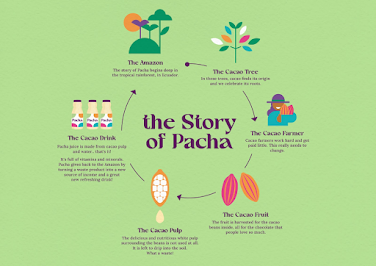Drink of the gods -- Cocoa Pulp?
COCOA JUICE AND PULP
The transformation of astringent cocoa seeds first into cocoa beans and then into chocolate bars is pretty miraculous. A large part of the magic is down to fermentation, when the sweet pulp surrounding the cocoa seeds reacts with different bacteria and yeasts in the local environment to transform the bitter, astringent cocoa seeds into cocoa beans that have some distinctly chocolate notes like nutty, caramel, earthy, citrus and woody flavours.
And if you ever have the chance to open and taste a fresh cocoa pod, you will know that the pulp is delicious. Depending on where you are and what cocoa pod you try, the pulp can have flavours that range from mango, lychee, citrus, peach, whey-like or even minerality. Indeed in South America many delicious desserts and drinks (both alcoholic and nonalcoholic) are often made from cocoa pulp.
However most cocoa pulp is “wasted”. Some of the pulp is literally left on the jungle floor, and much of it evaporates and drains away during fermentation.
And this is a shame, for a couple of reasons. Cocoa pulp is full of healthy vitamins and minerals, from magnesium and potassium to manganese and vitamin B1. It also makes up approximately 30% of the weight of a cocoa pod. Cocoa seeds (which become beans) account for another 20% and the husk and outer shell of the pod is about 50%. The husk or pod skin can be transformed into fuel, fertilizers or even paper. But the pulp is generally ignored and effectively “wasted”.
Until now.
With Pacha de Cacao, Marika has worked out a way to “bottle” the pulp for our benefit, and also to turn what was a waste product into another source of income for cocoa farmers.
MARIKA VAN SANTVOORT
Marika has had a rich and varied career. Born in the Netherlands, Marika studied human rights and then moved to Africa to work for various NGOs, including Amnesty International, before spending two years in Cameroon where she worked to support local prisoners. Whilst in Cameroon Marika fell into the world of cocoa, initially working on various cocoa sustainability projects before returning to the Netherlands. And since being back in the Netherlands, Marika has doubled down on cocoa and chocolate, helping to run Chocoa (the annual Dutch chocolate festival set up by Caroline Lubbers and Jack Steijn), setting up her a cocoa bean trading company that works directly with farmers (Gaia Cacao), and setting up Pacha de Cacao.
She describes Pacha de Cacao’s “Eureka” moment as when she was talking to a farmers in Ecuador who she saw “eating the pulp and spitting out the beans". He explained that savouring “cocoa pulp” gave him “good energy”. Having seen similar behaviour in Cameroon, she realised that cocoa pulp need not be a “waste product” but could become an intriguing new product and an additional source of income for farmers.
But there is remarkably little (published) research on cocoa pulp. There is some work on making alcoholic drinks out of cocoa pulp in South America. But very little has been done to make cocoa pulp into the next “coconut water”.
Marika has therefore spent the last few years developing her own processes and procedures from scratch. She currently works with two farms in Ecuador who remove a significant amount of the pulp before they ferment the cacao. And Marika works with a local Ecuadorean factory to pasteurise, remove fibres from the pulp, and then freeze it before shipping it to Amsterdam where the pulp is further purified and bottled.
For those interested in cocoa varietals and fermentation, one intriguing side note is that Marika may have – finally -- found a good use of CCN51, a high yielding cocoa clone invented in Ecuador back in the 1970s. See the blog for more details on why this mass-produced clone, memorably described as having the flavour of “acidic dirt”, may be improved by Marika’s processes.
PACHA DE CACAO (the name)…
"Pacha comes from the Quechua word for ‘soil’ and ‘earth’ and de cacao is Spanish for ‘of cacao’. Together they stand for ‘world of cacao’. We wanted to create a strong link to Pachamama, the female goddess, Mother Earth, who is an important concept in most of the Latin American cultures. We believe in giving back to Earth, and we do so by using the cacao pulp and preventing from it being wasted"
As Marika said, tastes great, great history --and a great new use of what would otherwise be a waste product.


